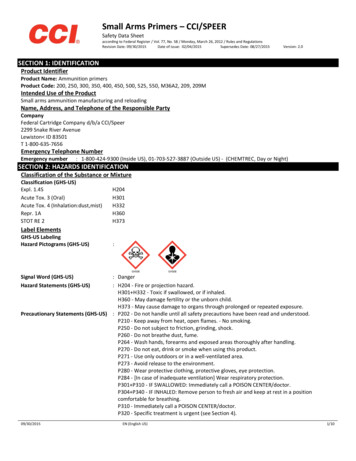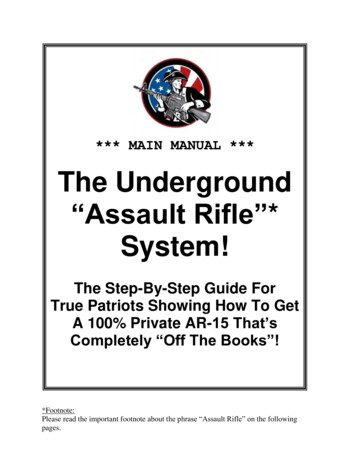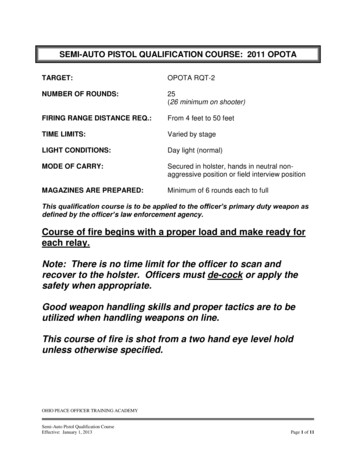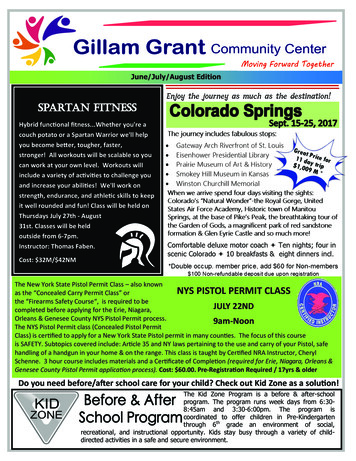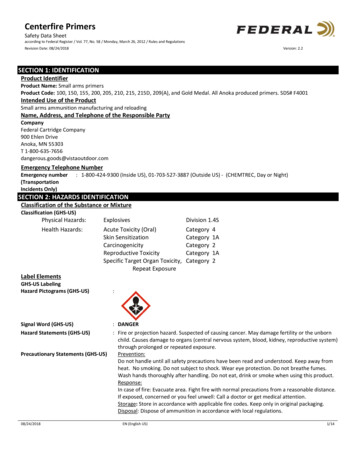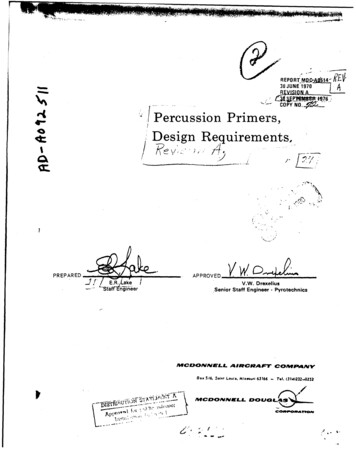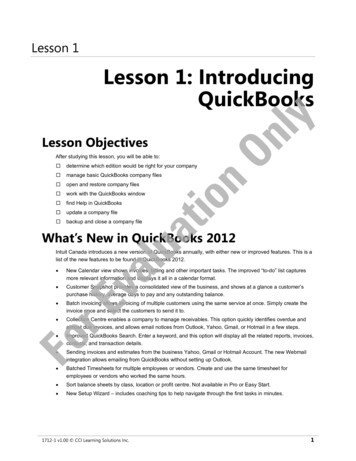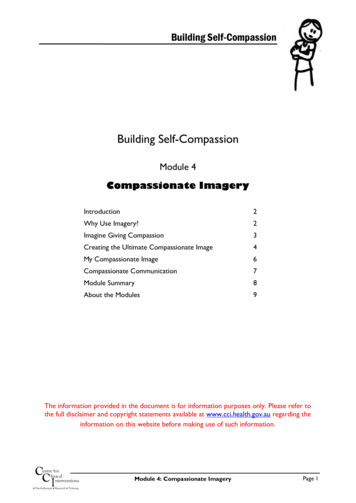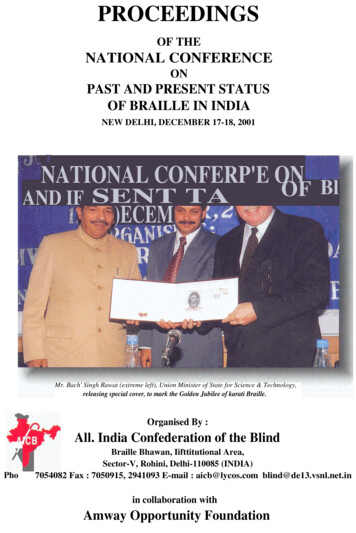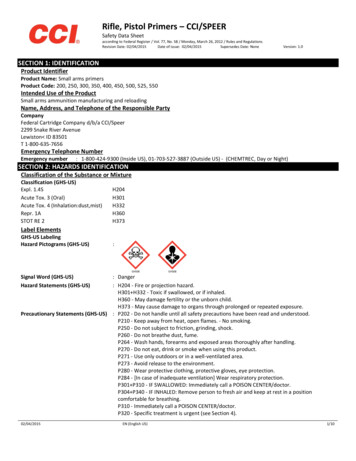
Transcription
Rifle, Pistol Primers – CCI/SPEERSafety Data Sheetaccording to Federal Register / Vol. 77, No. 58 / Monday, March 26, 2012 / Rules and RegulationsRevision Date: 02/04/2015Date of issue: 02/04/2015Supersedes Date: NoneVersion: 1.0SECTION 1: IDENTIFICATIONProduct IdentifierProduct Name: Small arms primersProduct Code: 200, 250, 300, 350, 400, 450, 500, 525, 550Intended Use of the ProductSmall arms ammunition manufacturing and reloadingName, Address, and Telephone of the Responsible PartyCompanyFederal Cartridge Company d/b/a CCI/Speer2299 Snake River AvenueLewiston ID 83501T 1-800-635-7656Emergency Telephone NumberEmergency number: 1-800-424-9300 (Inside US), 01-703-527-3887 (Outside US) - (CHEMTREC, Day or Night)SECTION 2: HAZARDS IDENTIFICATIONClassification of the Substance or MixtureClassification (GHS-US)Expl. 1.4SAcute Tox. 3 (Oral)Acute Tox. 4 (Inhalation:dust,mist)Repr. 1ASTOT RE 2H204H301H332H360H373Label ElementsGHS-US LabelingHazard Pictograms (GHS-US):GHS06GHS08Signal Word (GHS-US)Hazard Statements (GHS-US): Danger: H204 - Fire or projection hazard.H301 H332 - Toxic if swallowed, or if inhaled.H360 - May damage fertility or the unborn child.H373 - May cause damage to organs through prolonged or repeated exposure.Precautionary Statements (GHS-US) : P202 - Do not handle until all safety precautions have been read and understood.P210 - Keep away from heat, open flames. - No smoking.P250 - Do not subject to friction, grinding, shock.P260 - Do not breathe dust, fume.P264 - Wash hands, forearms and exposed areas thoroughly after handling.P270 - Do not eat, drink or smoke when using this product.P271 - Use only outdoors or in a well-ventilated area.P273 - Avoid release to the environment.P280 - Wear protective clothing, protective gloves, eye protection.P284 - [In case of inadequate ventilation] Wear respiratory protection.P301 P310 - IF SWALLOWED: Immediately call a POISON CENTER/doctor.P304 P340 - IF INHALED: Remove person to fresh air and keep at rest in a positioncomfortable for breathing.P310 - Immediately call a POISON CENTER/doctor.P320 - Specific treatment is urgent (see Section 4).02/04/2015EN (English US)1/10
Rifle, Pistol Primers – CCI/SPEERSafety Data Sheetaccording to Federal Register / Vol. 77, No. 58 / Monday, March 26, 2012 / Rules and RegulationsP330 - Rinse mouth.P361 - Take off immediately all contaminated clothing.P363 - Wash contaminated clothing before reuse.P374 - Fight fire with normal precautions from a reasonable distance.P401 - Store in accordance with, local, regional, national, territorial, provincial, andinternational regulations.P403 P233 - Store in a well-ventilated place. Keep container tightly closed.P501 - Dispose of contents according to local, regional, national, territorial, provincial, andinternational regulations.Other HazardsHazards Not Contributing to the Classification: Exposure may aggravate those with pre-existing eye, skin, or respiratory conditions.Lead and barium are toxic metals that may be released during the firing of primers. Care should be taken in the cleaning of rangefacilities to minimize the exposure potential to lead and barium. Persons engaged in these activities should wear protective clothingwith an appropriate respirator. Range operators should consult OSHA 1910.1025 for details pertaining to the handling of lead in thework environment.Unknown Acute Toxicity (GHS-US) Not availableSECTION 3: COMPOSITION/INFORMATION ON INGREDIENTSMixtureNameCopperProduct identifier(CAS No) 7440-50-8% (w/w)60-70Zinc(CAS No) 7440-66-62-30Barium(CAS No) 7440-39-31-21,3-Benzenediol, 2,4,6-trinitro-, lead salt(CAS No) 15245-44-01-2Classification (GHS-US)Comb. DustAquatic Acute 1, H400Aquatic Chronic 3, H412Aquatic Acute 1, H400Aquatic Chronic 1, H410Water-react. 2, H261Acute Tox. 3 (Oral), H301Skin Irrit. 2, H315Eye Irrit. 2A, H319STOT SE 3, H335Unst. Expl, H200Acute Tox. 4 (Oral), H302Acute Tox. 4 (Inhalation:dust,mist), H332Repr. 1A, H360STOT RE 2, H373Aquatic Acute 1, H400Aquatic Chronic 1, H410The ecotoxicological information applies to the materials encased within the product.Full text of H-phrases: see section 16SECTION 4: FIRST AID MEASURESDescription of First Aid MeasuresGeneral: Never give anything by mouth to an unconscious person. IF exposed or concerned: Get medical advice/attention.Inhalation: When symptoms occur: go into open air and ventilate suspected area. IF INHALED: Remove to fresh air and keep at rest ina position comfortable for breathing. Call a POISON CENTER or doctor/physician.Skin Contact: Remove contaminated clothing. Drench affected area with water for at least 15 minutes. Call a POISONCENTER/doctor/physician if you feel unwell. Wash contaminated clothing before reuse.Eye Contact: Rinse cautiously with water for several minutes. Remove contact lenses, if present and easy to do. Continue rinsing.Seek medical attention.Ingestion: Rinse mouth. Do not induce vomiting. Get medical advice and attention if you feel unwell.02/04/2015EN (English US)2/10
Rifle, Pistol Primers – CCI/SPEERSafety Data Sheetaccording to Federal Register / Vol. 77, No. 58 / Monday, March 26, 2012 / Rules and RegulationsMost Important Symptoms and Effects Both Acute and DelayedGeneral: Toxic if swallowed, in contact with skin or if inhaled. Projectiles from fired cartridges can cause puncture wounds. Whencartridges are fired or otherwise discharged, dust, vapors, and/or fumes may be absorbed by the digestive system and can result inboth acute and chronic overexposure. Ingestion of a complete primer can cause irritation to the digestive system, and possibly otherunknown health effects.Inhalation: Fatal if inhaled.Skin Contact: May cause skin irritation.Eye Contact: May cause eye irritation.Ingestion: Toxic if swallowed.Chronic Symptoms: May damage fertility. May damage the unborn child. May cause damage to organs through prolonged orrepeated exposure.Indication of Any Immediate Medical Attention and Special Treatment NeededIf you feel unwell, seek medical advice (show the label where possible).SECTION 5: FIRE-FIGHTING MEASURESExtinguishing MediaSuitable Extinguishing Media: Foam, water fog or spray. Fight fire with normal precautions from a reasonable distance.Unsuitable Extinguishing Media: Fight fire with normal precautions from a reasonable distance.Special Hazards Arising From the Substance or MixtureFire Hazard: May ignite if heated to 250 F (121 C) causing projection of unconfined primers.Explosion Hazard: Explosive. Explosion risk in case of fire.Reactivity: May detonate with friction, impact, and heat.Advice for FirefightersPrecautionary Measures Fire: Do not breathe fumes from fires or vapors from decomposition.Firefighting Instructions: Exercise caution when fighting any chemical fire. Fight fire with normal precautions from a reasonabledistance.Protection During Firefighting: Firefighters should wear full protective gear when fighting or downwind of initial fire.Hazardous Combustion Products: Metal oxides. Nitrogen oxides. Carbon oxides (CO, CO2).Reference to Other SectionsRefer to section 9 for flammability properties.SECTION 6: ACCIDENTAL RELEASE MEASURESPersonal Precautions, Protective Equipment and Emergency ProceduresGeneral Measures: Avoid skin and eye contact. Do not breathe dust or fumes. Remove ignition sources. No naked lights. Nosmoking. Evacuate danger area. Do not allow product to spread into the environment.For Non-Emergency PersonnelProtective Equipment: Use appropriate personal protection equipment (PPE).Emergency Procedures: Evacuate unnecessary personnel.For Emergency PersonnelProtective Equipment: Equip cleanup crew with proper protection.Emergency Procedures: Ventilate area.Environmental PrecautionsAvoid release to the environment.Methods and Material for Containment and Cleaning UpFor Containment: Contain and collect as any solid. Use only non-sparking tools.Methods for Cleaning Up: DO NOT SWEEP SPILLED PRIMERS INTO A PILE. Spray spilled primers with a water/detergent mixture. Donot allow primers to become dry.Reference to Other SectionsSee heading 8, Exposure Controls and Personal Protection.SECTION 7: HANDLING AND STORAGEPrecautions for Safe HandlingAdditional Hazards When Processed: Projectiles from fired cartridges can cause puncture wounds. Remove cartridges from serviceif any of the following conditions have occurred: corrosion, physical damage, exposure to oil or spray type lubricants.02/04/2015EN (English US)3/10
Rifle, Pistol Primers – CCI/SPEERSafety Data Sheetaccording to Federal Register / Vol. 77, No. 58 / Monday, March 26, 2012 / Rules and RegulationsHygiene Measures: Handle in accordance with good industrial hygiene and safety procedures. Wash hands and other exposed areaswith mild soap and water before eating, drinking, or smoking and again when leaving work. Contaminated work clothing should notbe allowed out of the workplace. Do no eat, drink or smoke when using this product. Wash contaminated clothing before reuse.Conditions for Safe Storage, Including Any IncompatibilitiesTechnical Measures: Proper grounding procedures to avoid static electricity should be followed. Ground/bond container andreceiving equipment.Storage Conditions: KEEP IN ORIGINAL CONTAINER. Store in a dry, cool and well-ventilated place. Keep container closed when notin use. Keep in fireproof place.Incompatible Materials: Strong acids. Strong bases. Strong oxidizers.Storage Area: Store locked up.Specific End Use(s) Small arms primerSECTION 8: EXPOSURE CONTROLS/PERSONAL PROTECTIONControl ParametersCopper (7440-50-8)USA ACGIHUSA OSHAUSA NIOSHUSA IDLHAlbertaBritish ColumbiaManitobaNew BrunswickNewfoundland & LabradorNova ScotiaNunavutNunavutNorthwest TerritoriesNorthwest TerritoriesOntarioPrince Edward IH TWA (mg/m³)OSHA PEL (TWA) (mg/m³)NIOSH REL (TWA) (mg/m³)US IDLH (mg/m³)OEL TWA (mg/m³)OEL TWA (mg/m³)OEL TWA (mg/m³)OEL TWA (mg/m³)OEL TWA (mg/m³)OEL TWA (mg/m³)OEL STEL (mg/m³)OEL TWA (mg/m³)OEL STEL (mg/m³)OEL TWA (mg/m³)OEL TWA (mg/m³)OEL TWA (mg/m³)VEMP (mg/m³)OEL STEL (mg/m³)OEL TWA (mg/m³)OEL STEL (mg/m³)OEL TWA (mg/m³)0.2 mg/m³1 mg/m³0.1 mg/m³100 mg/m³1 mg/m³0.2 mg/m³0.2 mg/m³1 mg/m³0.2 mg/m³0.2 mg/m³2 mg/m³1 mg/m³2 mg/m³1 mg/m³1 mg/m³0.2 mg/m³1 mg/m³3 mg/m³1 mg/m³2 mg/m³1 mg/m³Barium (7440-39-3)USA ACGIHAlbertaBritish ColumbiaManitobaNew BrunswickNewfoundland & LabradorNova ScotiaOntarioPrince Edward IslandSaskatchewanSaskatchewanACGIH TWA (mg/m³)OEL TWA (mg/m³)OEL TWA (mg/m³)OEL TWA (mg/m³)OEL TWA (mg/m³)OEL TWA (mg/m³)OEL TWA (mg/m³)OEL TWA (mg/m³)OEL TWA (mg/m³)OEL STEL (mg/m³)OEL TWA (mg/m³)0.5 mg/m³0.5 mg/m³0.5 mg/m³0.5 mg/m³0.5 mg/m³0.5 mg/m³0.5 mg/m³0.5 mg/m³0.5 mg/m³1.5 mg/m³0.5 mg/m³Exposure ControlsAppropriate Engineering Controls: Emergency eye wash fountains and safety showers should be available in the immediate vicinityof any potential exposure. Ensure adequate ventilation, especially in confined areas. Ensure all national/local regulations areobserved.02/04/2015EN (English US)4/10
Rifle, Pistol Primers – CCI/SPEERSafety Data Sheetaccording to Federal Register / Vol. 77, No. 58 / Monday, March 26, 2012 / Rules and RegulationsPersonal Protective Equipment: Gloves. Protective goggles. Protective clothing.Materials for Protective Clothing: Chemically resistant materials and fabrics.Hand Protection: Wear chemically resistant protective gloves.Eye Protection: Chemical goggles or safety glasses.Skin and Body Protection: Wash contaminated clothing before reuse.Respiratory Protection: Use a NIOSH-approved respirator or self-contained breathing apparatus whenever exposure may exceedestablished Occupational Exposure Limits.Environmental Exposure Controls: Do not allow the product to be released into the environment.Other Information: When using, do not eat, drink or smoke.SECTION 9: PHYSICAL AND CHEMICAL PROPERTIESInformation on Basic Physical and Chemical PropertiesPhysical StateAppearanceOdorOdor ThresholdpHEvaporation RateMelting PointFreezing PointBoiling PointFlash PointAuto-ignition TemperatureDecomposition TemperatureFlammability (solid, gas)Lower Flammable LimitUpper Flammable LimitVapor PressureRelative Vapor Density at 20 CRelative DensitySpecific GravitySolubilityPartition coefficient: n-octanol/waterViscosityExplosive propertiesExplosion Data – Sensitivity to Mechanical ImpactExplosion Data – Sensitivity to Static Discharge:::::::::::::::::::::::::SolidNot availableNot availableNot availableNot availableNot availableNot availableNot availableNot availableNot availableNot availableNot availableNot availableNot availableNot availableNot availableNot availableNot availableNot availableNot availableNot availableNot availableFire or projection hazardSensitive to mechanical impactNot sensitiveSECTION 10: STABILITY AND REACTIVITYReactivity: May detonate with friction, impact, and heat. Will not propagate.Chemical Stability: Risk of explosion by shock, friction, fire or other sources of ignition.Possibility of Hazardous Reactions: Hazardous polymerization will not occur.Conditions to Avoid: Heat. Sparks. Open flame. Overheating. Extremely high or low temperatures. Direct sunlight.Incompatible Materials: Strong acids. Strong bases. Strong oxidizers.Hazardous Decomposition Products: None known.SECTION 11: TOXICOLOGICAL INFORMATIONInformation on Toxicological Effects - ProductAcute Toxicity: Fatal if swallowed. Fatal if inhaled.LD50 and LC50 Data:02/04/2015EN (English US)5/10
Rifle, Pistol Primers – CCI/SPEERSafety Data Sheetaccording to Federal Register / Vol. 77, No. 58 / Monday, March 26, 2012 / Rules and RegulationsPowerloadsATE US (oral)5.00 mg/kg body weightATE US (dermal)50.00 mg/kg body weightATE US (dust, mist)0.05 mg/l/4hSkin Corrosion/Irritation: Not classifiedSerious Eye Damage/Irritation: Not classifiedRespiratory or Skin Sensitization: Not classifiedGerm Cell Mutagenicity: Not classifiedTeratogenicity: Not availableCarcinogenicity: Not classifiedSpecific Target Organ Toxicity (R
Rifle, Pistol Primers – CCI/SPEER Safety Data Sheet according to Federal Register / Vol. 77, No. 58 / Monday, March 26, 2012 / Rules and Regulations Revision Date: 02/04/2015 Date of issue: 02/04/2015 Supersedes Date: None Version: 1.0 02/04/2015 EN (English US) 1/10 SECTION 1: IDENTIFICATION Product Identifier Product Name: Small arms primers Product Code: 200, 250, 300, 350, 400, 450, 500 .
